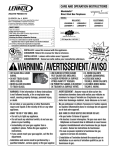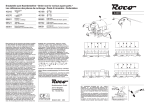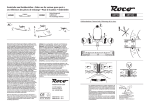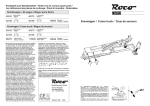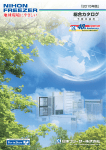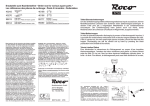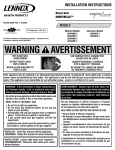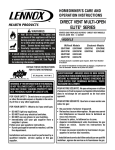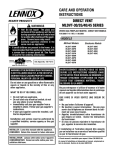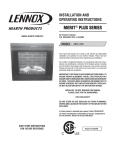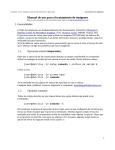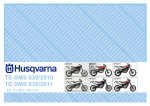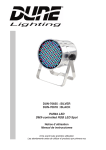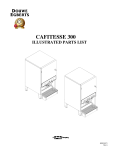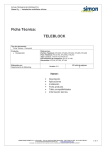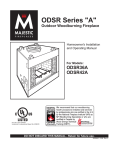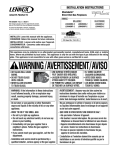Download Care & Operation Guide - Inglenook Energy Center
Transcript
care and operation instructions RETAIN THESE INSTRUCTIONS FOR FUTURE REFERENCE WARNINGS • Hot! Do not touch! The glass and surfaces of this appliance will be hot during operation and will retain heat for a while after shutting off the appliance. Severe burns may result. • Carefully supervise children in the same room as appliance. • If small children are present in the home, it is recommended that this appliance be fitted with a screen door or screen panel kit. See Page 11 for ordering information. WARNING: IF THE INFORMATION IN THIS MANUAL IS NOT FOLLOWED EXACTLY, A FIRE OR EXPLOSION MAY RESULT CAUSING PROPERTY DAMAGE, PERSONAL INJURY OR LOSS OF LIFE. FOR YOUR SAFETY: Do not store or use gasoline or other flammables or liquids in the vicinity of this or any other appliance. FOR YOUR SAFETY: What to do if you smell gas: •DO NOT light any appliance. •DO NOT touch any electrical switches. •Do not use any phone in your building. •Immediately call your gas supplier from a neighbor’s phone. Follow your gas suppliers instructions. •If your gas supplier cannot be reached, call the fire department. Installation and service must be performed by a qualified installer, service agency or the gas supplier. US OTL Report No. 116-F-22-5 DIRECT VENT MONTEBELLO™ TM VENTED GAS FIREPLACE - DIRECT VENT MODELS P/N 875,027M REV. E 08/2007 MODELS Millivolt Models LSM40MN-2 LSM40MP-2 LSM45MN-2 LSM45MP-2 Electronic Models LSM40EN-2 LSM45EN-2 A French manual is available upon request. Order P/N 875,027CF Ce manuel d’installation est disponible en francais, simplement en faire la demande. Numéro de la pièce 875,027CF AVERTISSEMENT: ASSUREZ-VOUS DE BIEN SUIVRE LES INSTRUCTIONS DONNÉ DANS CETTE NOTICE POUR RÉDUIRE AU MINIMUM LE RISQUE D'INCENDIE OU POUR ÉVITER TOUT DOMMAGE MATÉRIEL, TOUTE BLESSURE OU LA MORT. POUR VOTRE SÉCURITÉ: Ne pas entreposer ni utiliser d'essence ni d'autre vapeurs ou liquides inflammables dans le voisinage de cet appareil ou de tout autre appareil. POUR VOTRE SÉCURITÉ: Que faire si vous sentez une odeur de gaz: •Ne pas tenter d'allumer d'appareil. •Ne touchez à aucun interrupteur. Ne pas vous servir des téléphones se trouvant dans le batiment où vous vous trouvez. •Evacuez la piéce, le bâtiment ou la zone. •Appelez immédiatement votre fournisseur de gaz depuis un voisin. Suivez les instructions du fournisseur. •Si vous ne pouvez rejoindre le fournisseur de gaz, appelez le service dos incendies. L'installation et service doit être exécuté par un qualifié installeur, agence de service ou le fournisseur de gaz. SAFETY & WARNING INFORMATION Important: Please read THIS MANUAL IN ITS ENTIRETY and understand these Rules to follow for safety. WARNING If the information in this manual is not followed exactly, a fire or explosion may result causing property damage, personal injury or loss of life. WARNING Improper installation, adjustment, alteration, service or maintenance can cause injury or property damage. Refer to this manual. For assistance or additional information consult a qualified installer, service agency or the gas supplier. WARNING Failure to comply with the installation and operating instructions provided in this document will result in an improperly installed and operating appliance, voiding its warranty. Any change to this appliance and/or its operating controls is dangerous. Improper installation or use of this appliance can cause serious injury or death from fire, burns, explosion or carbon monoxide poisoning. IMPORTANT These appliances must not be connected to a chimney or flue serving a separate solid-fuel burning appliance. WARNING Do not place clothing or other flammable materials on or near this appliance. AVERTISSEMENT Surveiller les enfants. Garder les vêtements, les meubles, l'essence ou autres liquides à vapeur inflammables à cote de l'appareil. WARNING Children and adults should be alerted to the hazards of high surface temperatures. Use caution around the appliance to avoid burns or clothing ignition. Young children should be carefully supervised when they are in the same room as the appliance. Note: An Optional Screen Panel for the glass is available (see Page 11 for ordering information). WARNING Carbon Monoxide Poisoning: Early signs of carbon monoxide poisoning are similar to the flu with headaches, dizziness and/or nausea. If you have these signs, obtain fresh air immediately. Turn off the gas supply to the appliance and have it serviced by a qualified professional, as it may not be operating correctly. Some people are more affected by carbon monoxide than others. These include pregnant women, people with heart or lung disease or anemia, those under the influence of alcohol, and those at high altitudes. WARNING Any safety guard or screen removed for servicing the appliance must be replaced prior to operating the appliance. WARNING Do not attempt to alter or modify the construction of the appliance or its components. Any modification or alteration may void the warranty, certification and listings of this unit. WARNING Do not use these appliances if any part has been under water. Immediately call a qualified, professional service technician to inspect the appliances and to replace any parts of the control system and any gas controls which have been under water. AVERTISSEMENT Ne pas se servir de cet appareil s'il a été plongé dans l'eau, complètement ou en partie. Appeler un technicien qualifié pour inspecter l'appareil et remplacer toute partie du système de contrôle et toute commande qui ont été plongés dans l'eau. IMPORTANT The vent termination is hot while in operation and for a period of time following the use of the fireplace. Young children should be carefully supervised when they are in the same area as at hot termination. WARNING This appliance is only for use with the type of gas indicated on rating plate. This appliance is not convertible for use with other gases, unless a certified kit is used. AVERTISSEMENT Cet appareil doit être utilisé uniquement avec les types de gaz indiqués sur la plaque signalétique. Ne pas l'utiliser avec d'autres gaz sauf si un kit de conversion certifié est installé. WARNING These fireplaces are vented gas appliances. Do not burn wood or other material in these appliances. CONGRATULATIONS ON THE PURCHASE OF YOUR NEW GAS APPLIANCE MANUFACTURED BY LENNOX HEARTH PRODUCTS. When you purchased your new gas-fired fireplace, you joined the ranks of thousands of individuals whose answer to their home heating needs reflects their concern for efficiency and our environment. We extend our continued support to help you achieve the maximum benefit and enjoyment available from your new gas-fired fireplace. It is our goal at Lennox Hearth Products to provide you, our valued customer, with an appliance that will ensure years of trouble-free warmth and pleasure. Provide adequate clearances around air openings and adequate accessibility clearance for service and proper operation. Never obstruct the front openings of the appliance. Due to high temperatures the appliance should be located out of traffic and away from furniture and draperies. Locate furniture and window coverings accordingly. Thank you for selecting a Lennox Hearth Products gas-fired fireplace as the answer to your home supplemental heating needs. These appliances are designed to operate on natural gas or propane gas only. Sincerely, All of us at Lennox Hearth Products Millivolt Models Input of millivolt models is shown in the following table: TABLE OF CONTENTS Safety and Warning Information.........Page 2 Introduction........................................Page 3 General Information............................Page 3 Operation/Care of Your Appliance.......Page 4 Variable Flame Adjustment..................Page 5 Maintenance........................................Page 5 Maintenance Schedule........................Page 6 Front Glass Enclosure Panel, Removal and Installation..................Page 7 Burner Adjustments............................Page 7 Flame Appearance and Sooting...........Page 7 Adjustment..........................................Page 7 Logs, Glowing Embers, Volcanic Stone Placement..............................Page 8 Millivolt Appliance Checkout...............Page 9 Electronic Appliance Checkout............Page 9 Accessory Components......................Page 9 Wiring Diagrams.................................Page12 Warranty.............................................Page12 Replacement Parts..............................Page12 Product Reference Information...........Page12 Lighting Instructions – Millivolt..........Page13 Lighting Instructions – Electronic.......Page15 Troubleshooting Guide – Millivolt.......Page17 Troubleshooting Guide – Electronic....Page18 Replacement Parts List.......................Page19 Introduction The fireplace models covered in this manual are Direct-Vent, sealed combustion gas fireplaces designed for residential application. DirectVent appliances operate with the combustion chamber completely isolated from the inside atmosphere. All air for combustion is brought in from the outside and exhaust gases are vented through the same direct vent, vent system. The millivolt appliances are designed to operate on either natural or propane gas. A millivolt gas control valve with piezo ignition system provides safe, efficient operation. The electronic appliances are designed to operate on natural gas only. An electronic intermittent pilot system provides safe, efficient operation. External electrical power is required to operate these units. These appliances comply with National Safety Standards and are tested and listed by OMNITest Laboratories (Report No. 116-F-22-5) to ANSI Z21.50 (in Canada, CSA-2.22), and CAN/ CGA-2.17-M91 in both the USA and Canada as vented gas fireplaces. The Installation must conform to local codes or, in the absence of local codes, with the National Fuel Gas Code, ANSI Z223.1/NFPA 54 - latest edition, or the Natural Gas and Propane Installation Code, CSA B149.1 - latest edition. The appliance, when installed, must be electrically grounded in accordance with local codes or, in the absence of local codes, with the National Electrical Code, ANSI/NFPA 70 - latest edition, or the Canadian Electrical Code, CSA C22.1 - latest edition. General Information Note: Installation and repair should be performed by a qualified service person. The appliance should be inspected annually by a qualified professional service technician. More frequent inspections and cleanings may be required due to excessive lint from carpeting, bedding material, etc. It is imperative that the control compartment, burners and circulating air passage ways of the appliance be kept clean. S'assurer que le brùleur et le compartiment des commandes sont propres. Voir les instructions d'installation et d'utilisation qui accompagnent l'appareil. NOTE: DIAGRAMS & ILLUSTRATIONS ARE NOT TO SCALE. Millivolt Models with Manually-Modulated Gas Valve Natural Gas Propane Gas Model No. Input (BTU/Hr) Model No. Input (BTU/Hr) LSM40-2 40,000 to 50,000 LSM40-2 40,000 to 50,000 LSM45-2 47,000 to 60,000 LSM45-2 48,000 to 60,000 Table 1 Electronic Models Electronic models have a manually-modulated gas valve. Input of electronic models is shown in the following table: Electronic Models with Manually-Modulated Gas Valve Natural Gas Propane Gas Model No. Input (BTU/Hr) Model No. Input (BTU/Hr) LSM40-2 40,000 to 50,000 LSM40-2 40,000 to 50,000 LSM45-2 47,000 to 60,000 LSM45-2 48,000 to 60,000 Table 2 Table 3 shows the gas orifice size required for the elevations indicated. Model Orifice Size Nat. Prop. LSM40-2 .1405" (#28) .086" (#44) LSM45-2 .161" (#20) .093" (#42) Elevation Feet (meters) 0-4500 (0-1372) Table 3 Maximum manifold pressure is 3.5 in. W.C. (0.87 kPa) for natural gas and 10 in. W.C. (2.49 kPa) for LP/Propane gas. Test gauge connections are provided on the front of the millivolt and electronic gas control valve (identified OUT for the manifold side and IN for inlet pressure). Minimum inlet gas pressure to these appliances is 5.5 inches water column (1.37 kPa) for natural gas and 11 inches water column (2.74 kPa) for propane for the purpose of input adjustment. Maximum inlet gas supply pressure to these appliances is 10.5 inches water column (2.61 kPa) for natural gas and 13.0 inches water column (3.23 kPa) for propane. Refer to Figure 1 for access to the gas control valve. Millivolt appliances will be fitted with the gas control valve shown in Figure 2. Right Side Modesty Panel Appliances with electronic systems will be fitted with the electronic valve shown in Figure 3. Familiarize yourself with the gas control valve that your appliance uses. Access Plate Hi-Lo Extension Knob Millivolt Appliances To light millivolt appliances refer to the detailed lighting instructions found on Page 12 . Millivolt appliance lighting instructions may also be found on the pull out lighting instruction labels attached to the gas control valve. Gas Valve ON/OFF Switch The appliance must be isolated from the gas supply piping system (by closing its individual manual shut-off valve) during any pressure testing of the gas supply piping system at test pressures equal to or less than 1/2 psig (3.5 kPa). The appliance and its individual shut-off valve must be disconnected from the gas supply piping system during any pressure testing of that system at pressures in excess of 1/2 psig (3.5 kPa). Operation and care of your appliance Appliance operation may be controlled by the following means: the factory provided ON/OFF control switch, a remotely located optional wall switch or optional remote control. The mounted ON/OFF control switch is located on the right hand side of the appliance. See Figure 1. Burn-in Period During the first few fires of this appliance there will be some odor due to the curing of the paint and burning off of lubricants used in the manufacturing process. Piezo Igniter Control Compartment Access Millivolt Control Valve Shown Figure 1 Gas Controls / Control Compartment Access The gas controls can be found on the right hand side of the appliance. On millivolt systems, the piezo igniter, Hi/Lo flame adjustment knob, and pilot and main gas ON/OFF control knob are located on the right side. On both millivolt and electronic systems the gas valve is located on the right side of the appliance. See Figure 1. Operation of millivolt and electronic gas control systems are different. Before lighting and operating your appliance determine if you have a millivolt or electronic appliance. Depending on your use, the burn-in period may take a few hours or a few days. OFF Electronic appliances are fitted with an ON/OFF rocker switch for appliance ON/OFF control. See Figure 1 for its location. Once the pilot is lighted, the ON/OFF rocker switch will control the appliance ON/OFF operation. To operate: Toggle the switch between its ON and OFF positions. LO W HI P IL OT To light electronic appliances refer to the detailed lighting instructions found on Page 15 of these instructions respectively. Electronic appliance lighting instructions may also be found on the pull out lighting instruction labels attached to the gas control valve. Manifold Pressure Port Variable Flame Height Adjustment Pilot Adjustment Screw TPTH TP TH Figure 2 - SIT Millivolt Gas Valve NOTE: DIAGRAMS & ILLUSTRATIONS ARE NOT TO SCALE. Electronic Appliances - ON ti If your millivolt appliance is equipped with an optional remote wall switch or remote control kit and the pilot is lit, the appliance main burner may be turned on and off with the wall switch or remote control. Main Gas Control Knob P IL O T OUT A white film may develop on the glass front during the first few fires as part of the curing process. The glass should be kept clean during the first two weeks of use to prevent the film from baking on (making it very difficult to remove). See Glass Cleaning on Page 5. Inlet Pressure Port IN KEEP YOUR HOUSE WELL VENTILATED DURING THE CURING PROCESS. THE ODOR AND HAZE EMITTED DURING THE CURING PROCESS CAN BE QUITE NOTICEABLE AND MAY SET OFF A SMOKE DETECTOR. ENSURE THAT A SMOKE DETECTOR IS NOT LOCATED DIRECTLY ABOVE THE APPLIANCE OR TOO CLOSE TO THIS APPLIANCE (FOLLOW SMOKE DETECTOR MANUFACTURER'S INSTRUCTIONS FOR PROPER LOCATION). Millivolt appliances are fitted with an ON/OFF Rocker Switch for appliance ON/OFF control. See Figure 1 for its location. Once the pilot is lighted, the ON/OFF rocker switch will control the appliance ON/OFF operation. To operate: Toggle the switch between its ON and OFF positions. Inlet Pressure Gauge Port Always keep the appliance area clear and free from combustible materials, gasoline and other flammable liquids. Remember, Millivolt appliances have a continuous burning pilot flame. Exercise caution when using products with combustible vapors. LO HI Hi-Lo Flame Adjustment Knob Always turn off gas to the pilot (millivolt appliances) before cleaning. Before re-lighting, refer to the lighting instructions in this manual. Instructions are also found on pull-out lighting instruction labels attached to the gas valve. Manifold Pressure Gauge Port Pilot Adjustment Screw Figure 3 - SIT Electronic Gas Valve If your electronic appliance is equipped with an optional remote wall switch or remote control kit the appliance main burner may be turned on and off with the wall switch or remote control. Variable Flame Height Adjustment All appliances are equipped with a variable gas control valve. Flame height for these models may be adjusted through a range between fixed low and high settings, alternately, while the appliance is in operation. Use the extension knob (refer to Figure 1), to adjust the flame height as desired by sliding the knob over the variable flame adjustment knob located on the front of the valve (refer to Figure 2). Replace the extension knob back to the hanger after the adjustment. MAINTENANCE Refer to the maintenance schedule for maintenance tasks, procedures, periodicity and by whom they should be performed. Always verify proper operation of the appliance after servicing. Important: Turn off gas and any electrical power before servicing the appliance. Glass Cleaning (see Front Glass Enclosure Panel, Removal and Installation on Page 7) Note: Clean glass after first two weeks of operation (after Burn-In period is over) and then only when necessary and when the fireplace is cool. Wipe surface with clean, dampened, soft cloth. Follow with dry, soft towel as desired. Take care not to scratch the glass surface. The viewing glass should be cleaned periodically to remove any build-up caused from the following: • Initial curing of the high temperature paint and burning off of lubricants used in the manufacturing process may result in a film on the glass. • A white coating may form on the glass as a result of impurities and minerals in the fuel. It is recommended that the glass be cleaned two or three times during each heating season, depending on the circumstances present. The following cleaning solutions are approved for use to clean glass: • Non-ammonia based household cleaner • 50%-50% mix of white vinegar & water • Gas fireplace/stove glass cleaner Inspect Glass Gasket - Visually inspect the gasket on the backside of the glass enclosure panels. The gasket surface must be clean, free of irregularities and seated firmly. WARNING Do not use abrasive cleaners. Never clean the glass when it is hot. CAUTION Do not attempt to touch the front enclosure glass with your hands while the fireplace is in use. • During start-up, it is normal for condensation to form on the inside of the glass (this condensation and fog will usually disappear in a few minutes). The moisture can cause lint, dust and other airborne particles to cling to the glass surface. The appliance and venting system should be thoroughly inspected before initial use and at least annually by a qualified service technician. However, more frequent periodic inspections and cleaning should be performed by the homeowner. Homeowner must contact a qualified service technician at once if any abnormal condition is observed. Keep side control compartment clean by vacuuming or brushing at least twice a year. More frequent cleaning may be required due to excessive lint from carpeting, bedding materials, etc. It is important that control compartments, burners and circulating air passageways of the appliance be kept clean. NOTE: DIAGRAMS & ILLUSTRATIONS ARE NOT TO SCALE. MAINTENANCE SCHEDULE Annually (Before the onset of the Burning Season) MAINTENANCE TASK ACCOMPLISHING PERSON PROCEDURE Inspecting/Cleaning Burner, Logs and Controls Qualified Service Technician Inspect valve and ensure it is properly operating. Check piping for leaks. Vacuum the control compartment, fireplace logs and burner area. Check Flame Patterns and Flame Height Qualified Service Technician Refer to Figure 6 (LSM40-2) or Figure 7 (LSM45-2) on Page 8 and verify the flame pattern and height displayed by the appliance conforms to the picture. Flames must not impinge on the logs. Ensure flames are steady (not lifting or floating). Inspecting/Cleaning Pilot and Burner Qualified Service Technician Refer to Figure 8 (Millivolt) or Figure 9 (Electronic) on Page 9. Remove any surface build-up on pilot and burner assembly. Wipe the pilot nozzles, igniter/flame rod and hood. Ensure the pilot flame engulfs the flame sensor as shown. Checking Vent System Qualified Service Technician Inspect the vent system at the top and at the base (within the firebox) for signs of blockage or obstruction. Look for any signs of dislocation or deterioration of the vent components. Note: Excessive condensation can cause corrosion of caps, pipe & fittings (excessive condensation can be caused by long lateral runs, too many elbows and/or exterior portions of the system being exposed to cold weather). Also inspect wall straps or plumbers's tape to ensure it is secure and in place. Appliance Checkout Qualified Service Technician Perform the appropriate appliance checkout procedure detailed in this manual. Replacing Rockwool Ember Materials Homeowner/Qualified Service Technician Remove old ember materials (rockwool) and vacuum the ember placement area. Place new embers as described in the Ceramic Panel And Log Placement Guide accompanying this document and as shown in Figures 6 and 7. ACCOMPLISHING PERSON PROCEDURE Periodically (After the Burning Season) MAINTENANCE TASK Cleaning Firebox Interior Homeowner Carefully remove logs, rockwool, volcanic stone and vermiculite. Vacuum out interior of the firebox. Clean firebox walls and log grate. Replace logs, rockwool, vermiculite and volcanic stone as detailed in this manual. Check Flame Patterns and Flame Height Homeowner Refer to Refer to Figure 6 (LSM40-2) or Figure 7 (LSM45-2) on Page 8 and verify the flame pattern and height displayed by the appliance conforms to the picture. Flames must not impinge on the logs. Checking Vent System Homeowner Inspect the vent system at the top and at the base (within the firebox) for signs of blockage or obstruction. Look for any signs of dislocation of the vent components. Cleaning Front Glass Enclosure Panel Homeowner Clean as necessary following the directions provided in this manual. Do not touch or attempt to clean glass while hot. Front Glass Enclosure Panel, Removal and Installation top Flange Glass door Frame assembly Burner Adjustments Glass door Latch (2) WARNING Do not operate appliance with the glass front removed, cracked or broken. Replacement of the glass should be done by a licensed or qualified service technician. These are direct-vent appliances. They are designed to operate only when the front glass enclosure panel is installed. Generally the front glass enclosure panel should not be removed except to gain access to the components within the firebox. WARNING Handle this glass with extreme care! Glass is susceptible to damage – Do not scratch or handle roughly while reinstalling the glass door frame. WARNING Do not attempt to substitute the materials used on this door, or replace cracked or broken glass with any materials other than those provided by the appliance manufacturer. WARNING The glass door of this appliance must only be replaced as a complete unit as provided by the manufacturer. Do not attempt to replace broken, cracked or chipped glass separately. Refer to Figure 4 and remove the front glass door assembly as follows: To remove the firescreens, lift up the center of the rod to disengage it from the center bracket, bend down at center, hold left side with hand until it disengages from left side, being careful not to scratch paint. Slowly remove the rod from the right side. Remove the door modesty shield from the top flange glass door by pulling it up firmly with both hands until it is disengaged. Using a phillips screwdriver, unfasten two (2) screws located at the top of the glass frame. The following paragraphs address burner adjustment concerns and procedures. When lit for the first time, this appliance will emit a slight odor for an hour or two. This is due to the “burn-in” of internal paints and lubricants used in the manufacturing process. Flame Appearance and Sooting (see Figures 6 and 7 on Page 8) Appliances operated with air shutter openings that are too large will exhibit flames that are blue and transparent. These weak, blue and transparent flames are termed anemic. If the air shutter opening is too small sooting may develop. screws Firebox Floor Glass door assembly Figure 4 Tilt the glass frame at the top away from the unit. Lift it carefully off the bottom door track and set the door aside, protecting it from inadvertent damage. To install the front glass door assembly, proceed as follows: 1.Retrieve the glass door assembly. Visually inspect the gasket on the backside of the panel. The gasket surface must be clean, free of irregularities and seated firmly. 2.Position the door frame in front of the firebox opening and engage the bottom flange over the rail at the bottom of the firebox opening. 3.Swing the door up and back. Ensure the gasket seats evenly as the door draws shut. Engage the nut insert and fasten with two screws to secure the door. 4.Install the door modesty shield on top flange glass door as follows: grab the door modesty shield with both hands, with the open hem going down and engage it with the upper lip of the glass door frame by pushing it all the way down. Make sure the installed shield is firmly in place. 5.With the firescreen hanging on the screen rod, drop in the right side of the rod to the right modesty panel. Then drop in the left side of the rod through the slot of the left modesty panel. Make sure that the rod is supported by the bracket in the center of the fireplace. WARNING When reinstalling the glass door, the door latch screws must be securely tightened to prevent the glass door from falling out, which could potentially cause damage and possible injury. NOTE: DIAGRAMS & ILLUSTRATIONS ARE NOT TO SCALE. Sooting is indicated by black puffs developing at the tips of very long orange flames. Sooting results in black deposits forming on the logs, appliance inside surfaces and on exterior surfaces adjacent to the vent termination. Sooting is caused by incomplete combustion in the flames and a lack of combustion air entering the air shutter opening. To achieve a warm yellow to orange flame with an orange body that does not soot, the shutter opening must be adjusted between these two extremes. No smoke or soot should be present. Reposition the logs if the flames impinge on any of them. If the logs are properly positioned and sooting conditions exist, the air shutter opening on the main burner tube should be adjusted. Normally, the more offsets in the vent system, the greater the need for the air shutter to be opened further. WARNING Air shutter adjustment should only be performed by a qualified professional service technician. Ensure that the front glass door assembly is in place and sealed After adjustment. Adjustment To adjust the flame, move the adjustment air shutter (located on the lower venturi) back or forward to increase or reduce the air shutter opening, respectively. Position the air shutter to the factory setting as shown in Figure 5 on Page 8. Allow the burner to operate for at least 15 minutes. Observe the flame continuously. If it appears weak or sooty as previously described, adjust the air shutter until the flame appearance is as desired. Propane models may exhibit a flame pattern that may candle or appear stringy. If this is problematic or persists as the appliance is continually operated, adjust the air shutter closed as described in the previous paragraphs. Operate the appliance for a period of time as the effect diminishes, ensuring that the appliance does not develop sooty flames. When satisfied that the appliance operates properly, proceed to finish the installation. Leave the control knob in “ON” position and turn the remote switch “OFF.” air shutter opening WARNING The size and position of the log set was engineered to give your appliance a safe, reliable and attractive flame pattern. Any attempt to use a different in the fireplace will void the Warranty and will result in incomplete combustion, sooting, and poor flame quality. Carefully position the ceramic fiber logs and twigs over the burner as shown in Figure 6 (LSM40-2) or Figure 7 (LSM45-2) on this Page. Refer to the detailed log placement instructions provided in the CERAMIC PANEL AND LOG PLACEMENT GUIDE accompanying this document. Venturi orifice Proper twig placement is critical to prevent sooting. Twigs should be placed in the gaps between the flame peaks and should be positioned so that at no time they impinge the flames. Placement is the same for all colors and styles of logs. Gas Valve Burner Venturi Main Burner Factory Air Shutter Opening Setting - Inches (millimeter) Model Nat.Gas Propane Gas LSM40-2 1/16 (1.59) 9/32 (7.14) LSM45-2 1/16 (1.59) 9/32 (7.14) Figure 5 Log Placement Figure 6 (Birch Logs Shown) LSM40-2 Figure 7 (Rustic Oak Logs Shown) LSM45-2 WARNING Logs get very hot and will remain hot up to one hour after gas supply is turned off. Handle only when logs are cool. Turn off all electricity to the appliance before you install grate and logs, If applicable. WARNING This appliance is not meant to burn wood. Any attempt to do so could cause irreparable damage to your appliance and prove hazardous to your safety. NOTE: DIAGRAMS & ILLUSTRATIONS ARE NOT TO SCALE. NOTE: DIAGRAMS & ILLUSTRATIONS ARE NOT TO SCALE. Glowing Embers (Rockwool) Placement Refer to the detailed glowing embers placement instructions provided in the Ceramic Panel And Log Placement Guide accompanying this document. Ceramic Panel Placement Refer to the detailed ceramic panel placement instructions provided in the Ceramic Panel And LOG PLACEMENT GUIDE accompanying this document. Millivolt Appliance Checkout The pilot flame should be steady, not lifting or floating. Flame should be blue in color with traces of orange at the outer edge. The top 3/8" (10 mm) at the pilot generator (thermopile) and the top 1/8" minimum (tip) of the quick drop out thermocouple should be engulfed in the pilot flame. The flame should project 1" (25 mm) beyond the hood at all three ports. See Figure 8. With proper care and maintenance, your appliance will provide many years of enjoyment. If you should experience any problem, first refer to the trouble shooting guide in this manual. If problem persists, contact your Lennox Hearth Products distributor. Accessory Components Standard Remote Control System The Model RCL (Standard) Remote Control System, features a simple On/Off control function for the fireplace. This model includes a hand-held transmitter, a remote receiver with wall-mount coverplate and all hardware required to install the unit. The remote receiver can be wall or hearth mounted. Deluxe Remote Control System The Model RCL-T (Deluxe) Remote Control System has all of the features of the standard system along with an added easy to read LCD screen which presents access to many enhancements, including; battery power level indicator, timer, mode of operation, thermostatic display including room temperature in either metric of English units, flame indicator and clock. Fully programmable, the Model RCL-T allows for command over nearly all operational and temperature variables, using the hand held remote control transmitter. To light the burner, refer to the lighting instructions on Page 13. SIT MILLIVOLT PILOT ASSEMBLY Proper Pilot Flame Appearance Pilot Hood Igniter Rod Remote Control System (Deluxe) Thermocouple 3/8" Min. (9 mm) Remote Control System (Standard) H0249RCL Flame Modulating Remote Control Pilot Nozzels Figure 8 Thermopile Electronic Appliance Checkout To light the burner, refer to the lighting instructions on Page 15. Ensure the igniter lights the pilot. The pilot flame should engulf the flame sensor as shown in Figure 9. Flame Modulating Remote Controls were developed to provide a safe, reliable and user-friendly remote control system for appliances equipped with a Millivolt Gas Valve. A detailed set of instructions are included with each remote. H0251RCL-T Wall Thermostat The wall thermostat kit provides temperature control for optimum comfort. ELECTRONIC PILOT ASSEMBLY Proper Pilot Flame Appearance Pilot Hood Igniter Rod Flame Sensor Pilot Nozzels Figure 9 89L36 WTK Wall Thermostat Kit Flame Modulating Remote Control – Natural Gas Flame Modulating Remote Control – LP/Propane Gas H0301RCL-MN H0302RCL-ML NOTE: DIAGRAMS & ILLUSTRATIONS ARE NOT TO SCALE. Accessory Components Continued ON/OFF Wall Switch Kit The ON/OFF wall switch kit may be used to control the operation of the fireplace burner as an alternative to the unit mounted ON/OFF switch. Install the ON/OFF wall switch in a convenient location near the fireplace. Brick Liner Kits Log Sets The brick panel liner kits include ceramic panels of the side and rear walls. The panels have brick-like features in relief. Choose from two finely crafted log sets with detailing that replicates the natural look of real wood. Birch Logs Brick Liner Kits LSM40-2 ON/OFF Wall Switch Kit Cat. No. Model Description 85L87 FWSK Wall Switch Bag of Glowing Embers Bag of Volcanic Stone Bag of Vermiculite H2219 BLKR-LSM40 Buff Rustic H4801 BLK-REDR-LSM40 Red Rustic H2220 BLKH-LSM40 Buff Herringbone H4803 BLK-REDH-LSM40 Red Herringbone H2221 BLKC-LSM40 Red Old Cottage H2222 BLKB-LSM40 Black Replacement ember material, volcanic stone and vermiculite are available for use with these appliances. Order them to replace materials as part of the periodic maintenance of the appliance. H2223 BLKR-LSM45 Buff Rustic H2224 BLKH-LSM45 Buff Herringbone H2225 BLKC-LSM45 Red Old Cottage Black Model 88L53 FGE Bag of Glowing Embers 80L42 FDVS Bag of Volcanic Stone 10 Log Sets Cat. No. Model Description LSM40-2 and LSM45-2 H2226 BLKB-LSM45 H4802 BLK-REDR-LSM45 Red Rustic H4799 LOG-OAK-LSM-2 Oak Log Set H4804 BLK-REDH-LSM45 Red Herringbone H4800 LOG-BIR-LSM-2 Birch Log Set Firebox Accessories Cat. No. H3696 Rustic Oak LSM45-2 Description Bag of Vermiculite NOTE: DIAGRAMS & ILLUSTRATIONS ARE NOT TO SCALE. Accessory Components Continued Barrier Screen Kits Andiron Door Kits Dual Arch Screen Kits These Barrier Screen Panel kits can be installed on the glass enclosure panel to help prevent direct human contact with the hot glass surface. The andiron kits attach to the grate assembly without the use of hardware. These Dual Arch screen kits can be installed on the glass enclosure panel to help prevent direct human contact with the hot glass surface. CLASSIC MISSION Andiron Door Kits Dual Arch Screen Kits Cat. No. Model Description Barrier Screen Kits Cat. No. LSM40-2 H5051 Description LSM40-2 DASK-LSM40-2 Dual Arch Screen H4805 LSM45-2 H5054 Model BSK40 Fits Fireplace Models Catalog No. (Model) Mission Classic LSM40-2 & LSM45-2 H2227 (AKM-LSM) H2228 (AKC-LSM) Barrier Screen LSM45-2 DASK-LSM45-2 Dual Arch Screen H4806 BSK45 Barrier Screen Touch-Up Paint Kit Repair of minor scratches and discoloration of the appliances black painted surfaces may be accomplished with the touch-up paint kit. Classic Screen Kits Arch Screen Kits These Screen kits can be installed on the glass enclosure panel to help prevent direct human contact with the hot glass surface. These Arch Screen kits can be installed on the glass enclosure panel to help prevent direct human contact with the hot glass surface. PA I N T Touch-Up Paint (Black) Kit Model Description Cat. No. SK-LSM40-2 Classic Screen Kit H5053 SK-LSM45-2 Classic Screen Kit 90L73 FTPK-B Black Paint Kit Model Description ASK-LSM40-2 Arch Screen Kit LSM45-2 LSM45-2 H5055 Description LSM40-2 LSM40-2 H5052 Model Arch Screen Kits Classic Screen Kits Cat. No. Cat. No. H5056 ASK-LSM45-2 Arch Screen Kit NOTE: DIAGRAMS & ILLUSTRATIONS ARE NOT TO SCALE. 11 Wiring Diagrams piLot Burner iGniter-sensor asseMBLY eV2 optionaL accessorY sW eV1 Gas VaLVe red Gnd connector W WHite (20) oranGe (20) Ground BLK purpLe (9) Junction BoX BLK BLacK (20) If any of the original wire as supplied must be replaced, it must be replaced with Type AWM 105 C – 18 GA. wire. transF 120 V. W WHite (6) Green Led TH TP TP BLacK (16) eLectronic iGnition controL Board Field Wired Factory Wired APPLIANCE-MOUNTED ON/OFF SWITCH *WaLL Mounted on/oFF sWitcH (optionaL) or reMote controL receiVer *OR OPTIONAL WALL-MOUNTED ON/OFF SWITCH OR OPTIONAL REMOTE CONTROL RECEIVER *turn the appliance-Mounted on/oFF Burner control switch to the oFF position if an optional control switch is installed *Turn the appliance-mounted ON/OFF burner control switch to the OFF position if an optional control switch is installed. FieLd Wired Schematic Representation Only Figure 10 Replacement parts Your gas appliance is covered by a limited twenty year warranty. You will find a copy of the warranty accompanying this manual. Please read the warranty to be familiar with its coverage. A complete parts list is found at the end of this manual. Use only parts supplied from the manufacturer. Normally, all parts should be ordered through your Lennox Hearth Products distributor or dealer. Parts will be shipped at prevailing prices at time of order. Product reference information We recommend that you record the following important information about your fireplace. Please contact your Lennox Hearth Products dealer for any questions or concerns. For the number of your nearest Lennox Hearth Products dealer, please call 1-800-9-LENNOX Your Fireplace's Model Number_________________________________________ Your Fireplace's Serial Number_________________________________________ The Date On Which Your Fireplace Was Installed____________________________ The Type of Gas Your Fireplace Uses_____________________________________ Your Dealer's Name _ ________________________________________________ 12 FactorY Wired Figure 11 Warranty Retain this manual. File it with your other documents for future reference. 24 V. appLiance Mounted on/oFF sWitcH TH Thermopile 120 Vac BLK W Gnd BLue (20) Caution: Label all wires prior to disconnection when servicing controls. Wiring errors can cause improper and dangerous appliance operation. Millivolt Wiring Diagram eLectronic WirinG diaGraM WHite Green (12) Wiring diagrams are provided here for reference purposes only. This information is also provided on schematics attached directly to the appliance on a pullout panel located within the control compartment. With proper care and maintenance, your appliance will provide many years of enjoyment. If you should experience any problem, first refer to the troubleshooting guide in this manual. If problem persists, contact your Lennox Hearth Products dealer or distributor. Normally, all parts should be ordered through your Lennox Hearth Products distributor or dealer. Parts will be shipped at prevailing prices at time of order. When ordering repair parts, always give the following information: 1. The model number of the appliance. 2. The serial number of the appliance. 3. The part number. 4. The description of the part. 5. The quantity required. 6. The installation date of the appliance. If you encounter any problems or have any questions concerning the installation or application of this system, please contact your dealer or distributor. LENNOX HEARTH PRODUCTS 1110 West Taft Avenue Orange, CA 92865 visit us at www.Lennox.com Lighting Instructions – Millivolt GAS VALVE FOR YOUR SAFETY READ BEFORE LIGHTING WARNING: IF YOU DO NOT FOLLOW THESE INSTRUCTIONS EXACTLY, A FIRE OR EXPLOSION MAY RESULT CAUSING PROPERTY DAMAGE, PERSONAL INJURY OR LOSS OF LIFE. A. This appliance has a pilot which must be lighted with a piezo igniter. When lighting the pilot, follow these instructions exactly. B. BEFORE OPERATING smell all around the appliance area for gas. Be sure to smell next to the floor because some gas is heavier than air and will settle on the floor. WHAT TO DO IF YOU SMELL GAS • • • • Extinguish any open flame. Open windows. Do not light any appliance. Do not touch any electrical switches. • Do not use any phone in your building. • Immediately call your gas supplier from a neighbor’s phone. • If your gas supplier cannot be reached, call the fire department. C. Use only your hand to push in or turn the gas control knob. Never use tools. If the knob will not push in or turn by hand, do not try to repair it, call a qualified service technician. Force or attempted repair may result in a fire or an explosion. D. Do not use this appliance if any part has been under water. Immediately call a qualified service technician to inspect the appliance and to replace any part of the control system and any gas control which has been under water. LIGHTING INSTRUCTIONS 1.STOP! Read the safety information above on this Page. 2. Set the thermostat to the lowest setting, if applicable. 3. Turn off all electric power to the appliance, if applicable. 4. Remove the control access panel. 5. Push in gas control knob slightly and turn clockwise to “OFF.” IN OUT TPTH TP HI TH LO W 7. Push in gas control knob slightly and turn counterclockwise to “PILOT.” 8. Push in control knob all the way and hold in. Immediately light the pilot by triggering the spark igniter (pushing the button) until pilot lights. Continue to hold the control knob in for about 1-1/2 minutes after the pilot is lit. Release knob and it will pop back up. Pilot should remain lit. If it goes out, repeat steps 5 through 8. • If knob does not pop up when released, stop and immediately call your service technician or gas supplier. • If pilot will not stay lit after several tries, turn the control knob to “OFF” and call your service technician or gas supplier. O FF ti P IL O T ON PIL OT Note: Knob cannot be turned from “PILOT” to “OFF” unless the knob is pushed in slightly. Do not force. 6. Wait five (5) minutes to clear out any gas. If you then smell gas, STOP! Follow “B” in the safety information above on this Page. If you do not smell gas, go to the next step. 9. Turn gas control knob counterclockwise to “ON.” 10. Close control access panel. 11. Turn on all electric power to the appliance. 12. Set thermostat to desired setting. TO TURN OFF GAS TO APPLIANCE 1. Set the thermostat to the lowest setting. 2. Turn off all electric power to the appliance, if service is to be performed 4. Depress gas control knob slightly and turn clockwise to “OFF.” Do not force. 5. Close control access panel. 3. Remove control access panel. 13 INSTRUCTIONS D’ALLUMAGE – VANNE GAZ Millivolt POUR VOTRE SÉCURITÉ, LISEZ CES INSTRUCTIONS AVANT L’ALLUMAGE AVERTISSEMENT : SI VOUS NE SUIVEZ PAS CES INSTRUCTIONS À LA LETTRE, IL POURRAIT S’EN SUIVRE UN INCENDIE OU UNE EXPLOSION CAUSANT DES DOMMAGES MATÉRIELS, DES BLESSURES CORPORELLES OU MÊME DES PERTES DE VIE. A. Cet appareil est muni d’une veilleuse qui doit être allumée avec un allumeur piézo-électrique. Lorsque vous allumez la veilleuse, suivre exactement ces instructions. B. AVANT L’ALLUMAGE: Assurez-vous que vous ne détectez aucune odeur de gaz autour de l’apareil ainsi que près du sol; certains gaz, étant plus lourds que l’air, descendent au niveau du sol. VOICI CE QUE VOUS DEVEZ FAIRE SI VOUS DÉCELEZ UNE ODEUR DE GAZ: • Éteignez toute flamme visible. • Ouvrez les fenêtres. • N’allumez aucun appareil. • Ne touchez à aucun commutateur électrique. • Ne vous servez d’aucun téléphone dans votre édifice. • Appelez immédiatement votre compagnie de gaz en utilisant le téléphone du voisin. • S’il vous est impossible de contacter votre compagnie de gaz, appelez le service des incendies. C. N’utilisez que votre main pour manipuler le bouton de réglage du gaz. N’utilisez jamais d’outils. Si le bouton refuse de tourner ou de bouger, n’essayez pas de le réparer. Communiquez immédiatement avec un technicien de service qualifié. Toute tentative pour le forcer ou le réparer, risquerait de provoquer un incendie ou une explosion. D. Ne vous servez pas de cet appareil si l’un de ses éléments a été immergé dans l’eau. Appelez immédiatement un technicien compétent pour faire inspecter l’appareil et remplacer toute pièce du système de réglage ou commande du gaz qui a été sous l’eau. INSTRUCTIONS D'ALLUMAGE 1. 2. 3. 4. ARRÊTEZ! Lisez les consignes de sécurité au verso de cette plaque. Ouvrez le compartiment de contrôle du bas. Tournez l’interrupteur mural à la position d’arrêt “OFF”. Assurez-vous que la soupape d’arrêt de la canalisation principale est ouverte. 5. Enfoncez légèrement le bouton de réglage du gaz et tournez-le dans le sens des aiguilles d’une montre jusqu’à la position d’arrêt “OFF”. IN OUT TPTH TP HI TH LO W O FF ti P IL O T ON PIL OT Remarque: Il est impossible de tourner le bouton de “PILOT” à “OFF” à moins qu’il ne soit légèrement enfoncé. Ne le forcez pas. 6. Attendez cinq (5) minutes pour l’evacuation du gaz. Si vous décelez une odeur de gaz, ARRÊTEZ ! Retournez au point “B” des consignes de sécurité au verso de cette plaque. Si vous ne remarquez aucune odeur de gaz, passez à l’étape suivante. 7. Enfoncez légèrement le bouton de réglage du gaz et tournez-le en sens inverse des aiguilles d’une montre jusqu’à la position de veilleuse “PILOT”. 8. Enfoncez le bouton de réglage jusqu’au fond et gardez-le enfoncé. Allumez immédiatement la veilleuse en déclenchant l’allume-gaz à étincelle (en poussant le bouton) jusqu’à ce que la veilleuse s’enflamme. Continuez de tenir le bouton de réglage enfoncé pendant environ 90 secondes après l’allumage de la veilleuse. Relâchez le bouton et il sortira subitement. La veilleuse devrait rester allumée. Si elle s’éteint, répétez les étapes 5 à 8 inclusivement. • Si le bouton ne sort pas automatiquement après avoir été relâché, arrêtez immédiatement et téléphonez à votre technicien de service ou à votre fournisseur de gaz. • Si la veilleuse refuse de rester allumée après plusieurs tentatives, tournez le bouton de réglage jusqu’à sa position d’arrêt “OFF” et téléphonez à votre technicien de service ou à votre fournisseur de gaz. 9. Tournez le bouton de réglage du gaz en sens inverse des aiguilles d’une montre jusqu’à sa position de marche “ON”. 10. Fermez le compartiment de contrôle du bas. 11. Au besoin, rebrancher l’appareil au courant électrique et remettre l’interrupteur du brûleur principal à la position “ON” ou régler le thermostat à la température désirée. 12. Si l’appareil ne fonctionne pas, suivre les instructions intitulées “Pour fermer le gaz qui alimente l’appareil” et appeler un technicien ou le fournisseur de gaz. POUR FERMER LE GAZ QUI ALIMENTE L’APPAREIL 1. Tournez l’interrupteur mural à la position d’arrêt “OFF”. La veilleuse restera allumée jusqu’au retour du service normal. 2. Pour une fermeture complète, tournez l’interrupteur mural à la position d’arrêt “OFF”. 14 3. Ouvrez le compartiment de contrôle du bas. 4. Enfoncez légèrement le bouton de réglage du gaz et tournez-le dans le sens des aiguilles d’une montre jusqu’à la position d’arrêt “OFF”. Ne forcez pas le bouton. 5. Fermez le compartiment de contrôle du bas. Lighting Instructions — Electronic FOR YOUR SAFETY READ BEFORE LIGHTING WARNING: IF YOU DO NOT FOLLOW THESE INSTRUCTIONS EXACTLY, A FIRE OR EXPLOSION MAY RESULT CAUSING PROPERTY DAMAGE, PERSONAL INJURY OR LOSS OF LIFE. A.When lighting the appliance, follow these instructions exactly. B.BEFORE OPERATING smell all around the appliance area for gas. Be sure to smell next to the floor because some gas is heavier than air and will settle on the floor. WHAT TO DO IF YOU SMELL GAS • • • • • Extinguish any open flame. Open windows. Do not light any appliance. Do not touch any electrical switches. Do not use any phone in your building. • Immediately call your gas supplier from a neighbor’s phone. • If your gas supplier cannot be reached, call the fire department. C. Use only your hand to turn the gas control lever. Never use tools. If the lever will not turn by hand, do not try to repair it, call a qualified service technician. Force or attempted repair may result in a fire or an explosion. D. Do not use this appliance if any part has been under water. Immediately call a qualified service technician to inspect the appliance and to replace any part of the control system and any gas control which has been under water. LIGHTING INSTRUCTIONS 1.STOP! Read the safety information above on this Page. 2. Turn remote wall switch to "OFF" or set the thermostat to lowest setting, if applicable. 3. Turn the ON/OFF switch to "OFF" if Step 2 is applicable, this ON/OFF switch should always be in the "OFF" position. 6. Wait five (5) minutes to clear out any gas. If you then smell gas, including near the floor, STOP! Follow "B" in the safety information above on this Page. 7. Turn "ON" all electrical power to appliance (remote wall switch), or set the thermostat to the desired setting, if applicable. 8. Turn the ON/OFF switch on the appliance to "ON", if Step 7 is not applicable. 4. Verify main line shut-off valve is open. 9. If the appliance will not operate, follow the instructions "To Turn Off Gas To Appliance" and call your service technician or gas supplier. HI LO TO SHUT OFF Gas Valve 5. This appliance is equipped with an ignition device which automatically lights the burner. Do Not try to light the burner by hand. 1. Turn off all electrical power to the appliance (remote wall switch) or set the thermostat to the lowest setting, if applicable. TO TURN OFF GAS TO APPLIANCE 1. For complete shut-down, turn remote wall switch to "OFF" or set the thermostat to the lowest setting, if applicable. 3. Close the main line shut-off valve. 2. Turn the ON/OFF switch to “OFF”, if Step 1 is not applicable. 15 INSTRUCTIONS D’ALLUMAGE — Electronic POUR VOTRE SÉCURITÉ, LISEZ CES INSTRUCTIONS AVANT L’ALLUMAGE AVERTISSEMENT: SI VOUS NE SUIVEZ PAS CES INSTRUCTIONS À LA LETTRE, IL POURRAIT S’EN SUIVRE UN INCENDIE OU UNE EXPLOSION CAUSANT DES DOMMAGES MATÉRIELS, DES BLESSURES CORPORELLES OU MÊME DES PERTES DE VIE. A. Lorsque vous allumez l’appareil, suivez exactement ces instructions. B.AVANT L’ALLUMAGE: Assurez-vous que vous ne détectez aucune odeur de gaz autour de l’apareil ainsi que près du sol; certains gaz, étant plus lourds que l’air, descendent au niveau du sol. VOICI CE QUE VOUS DEVEZ FAIRE SI VOUS DÉCELEZ UNE ODEUR DE GAZ • Éteignez toute flamme visible. • Ouvrez les fenêtres. • N’allumez aucun appareil. • Ne touchez à aucun commutateur électrique. • Ne vous servez d’aucun téléphone dans votre édifice. • Appelez immédiatement votre compagnie de gaz en utilisant le téléphone du voisin. • S’il vous est impossible de contacter votre compagnie de gaz, appelez le service des incendies. C. N’utilisez que votre main pour manipuler linterrupteur “ON/OFF” de la valve à gaz. N’utilisez jamais d’outils. Si l’interrupteur ne bouge pas manuellement, n’essayez pas de le réparer. Communiquez immèdiatement avec un technicien de service qualifié. Toute tentative pour forcer l’interrupteur ou le réparer, risquerait de provoquer un incendie ou une explosion. D.Ne vous servez pas de cet appareil si l’un de ses éléments a été immergé dans l’eau. Appelez immédiatement un technicien compétent pour faire inspecter l’appareil et remplacer toute pièce du système de réglage ou commande du gaz qui a été sous l’eau. INSTRUCTIONS D’ALLUMAGE 1.ARRÊTEZ ! Lisez les consignes de sécurité au verso de cette plaque. 2. Tournez l’interrupteur mural à la position d’arrêt “OFF” ou plaez le thermostat à plssible, si requis. 3. Tournez l’interrupteur "marche/arrêt" à la position "arrêt" (Off) si l'etape 2 est appropriee. Cet interrupteur "marche/arrêt" devrait toujours être en position "arrêt" (Off). 4. Assurez-vous que la soupape d "arrêt" de la canalisation principale est ouverte. HI LO 6. Attendez cinq (5) minutes pour l’evacuation du gaz. Si vous décelez une odeur de gaz ARRÊTEZ ! Retournez au point “B” des consignes de sécurité au verso de cette plaque. Si vous ne remarquez aucune odeur de gaz, passez à l’étape suivante. 7. Tournez l'interrupteur mural à distance à la position "marche" (On) ou placez le thermostat à la temperature désarée, si requis. 8. Tournez l'interupteur "marche/arrét" de l'appareil à la position "marche" (On), si aucune odeur de gaz n a été détectée à l'étape 6. 9. Si l’appareil ne se met pas en marche, suivre les instructions intitulées “Pour fermer le gaz qui alimente l’appareil” et appeler un technicien ou le fournisseur de gaz. POUR ÉTEINDRE L’APPAREIL Vue de Face 5. Cet appareil est êquipê d'un dispositif d'allumage qui allume automatiquement le bruleur. N'essayez pas d'allumer le bruleur à la main. 1. Coupez tout le courant électrique qui alimente l’appareil (interrupteur mural) ou placez le thermostat à la plus basse température, si requis. POUR FERMER LE GAZ QUI ALIMENTE L’APPAREIL 1. Pour une fermeture complète, tournez l’interrupteur mural à la position d’arrêt “OFF”. 2. Tournez la manette de réglage du gaz à la position d’arrêt “OFF”. Ne la forcez pas. 16 3. Fermez la soupape d’arrêt de la canalisation principale. TROUBLESHOOTING GUIDE - Millivolt GAS CONTROL SYSTEM Note: Before troubleshooting the gas control system, Ensure external gas shut off valve, located at gas supply inlet, (and wall switch, iff applicable), is in the “ON” position. Important: Valve system troubleshooting should only be accomplished by a qualified service technician. SYMPTOM POSSIBLE CAUSES CORRECTIVE ACTION 1. Spark igniter will not light pilot after repeated triggering of igniter button. A. Defective igniter (no spark at electrode). Check for spark at electrode and pilot; if no spark and electrode wire is properly connected, replace igniter. B. Defective or misaligned electrode at pilot (spark at electrode). Using a match, light pilot. If pilot lights, turn off pilot and trigger the igniter button again. If pilot lights, an improper gas mixture caused the bad lighting and a longer purge period is recommended. If pilot will not light – check gap at electrode and pilot – should be 1/8" to have a strong spark. If gap measures 1/8", replace pilot (see Figures 8 or 9 on Page 9). C. Gas supply pressure errant. Check inlet gas pressure. It should be within the limits as marked on the rating plate. D. Pilot orifice plugged. Clean or replace pilot orifice. A. Defective pilot generator (thermocouple) Check pilot flame, it must impinge on thermocouple (see Figures 8 or 9 on Page 9). Clean and/or adjust pilot for maximum flame impingement on thermocouple. Ensure that the connection between the valve and thermocouple are tight and secure. WARNING: if the pilot will not light after 1 minute of attempting, wait for at least 5 minutes for gas to clear before attempting again. 2. Pilot will not stay lit after carefully following the lighting instructions. 3. Pilot burning, no gas to burner, Valve A. Wall switch or wires defective. knob “ON,” and the (standard) burner OFF/ON switch is “ON." Read important note below. IMPORTANT NOTE: If an optional *remote switch is used for burner operation, if the standard burner OFF/ON switch is still installed on appliance it must be in the "OFF" position. *Optional remote switch kits - wall switch, wall thermostat or remote control. 4. Frequent pilot/burner outage problem. Check wall switch and wires for proper connections. Jumper wire across terminals at wall switch, if burner comes on, replace defective wall switch. If okay, jumper wires across wall switch wires at valve, if burner comes on, wires are faulty or connections are bad. B. Thermopile may not be generating sufficient millivolts. Check thermopile with millivolt meter. Take reading at thermopile terminals of gas valve. Should read 325 millivolts minimum with optional wall switch “OFF.” Replace faulty thermopile if reading is below specified minimum. C. Plugged burner orifice. Check burner orifice for blockage and remove. D. OFF/ON Switch & *Remote Switch are in the "ON" position resulting in excessive resistance. When turning on the burner using a *remote switch, ensure that the standard OFF/ON switch is in the "OFF" position. If both switches are in the ON position, it may result in excessive resistance (& millivolt drainage) and the burner may not come on. A. Pilot flame may be too low or blowing (high) causing the pilot/valve safety to drop out. Clean and/or adjust pilot flame for maximum flame impingement on thermocouple (see Figures 8 or 9 on Page 9). 17 TROUBLESHOOTING GUIDE - ELECTRONIC GAS CONTROL SYSTEM Note: Before troubleshooting the gas control system, Ensure external gas shut off valve, located at gas supply inlet, (and wall switch, if applicable), is in the “ON” position. Important: Valve system troubleshooting should only be accomplished by a qualified service technician. SYMPTOM 1. Nothing happens when ON/OFF switch is turned on (pilot does not spark). 2. The main burner does not light and the igniter is sparking. POSSIBLE CAUSES CORRECTIVE ACTION A. Low voltage/or bad lead wires. Check voltage on AC terminals of module. The value should be around 24 VAC. Confirm that wire connections are secure. B. Damaged igniter wire. Check for visible cracked casing, cuts, etc. C. Damaged pilot assembly. Check pilot assembly for visibly broken spark electrode, etc. D. Batteries Low Check voltage on D.C. terminal of batteries in remote control. The value should be around 3.0V A. No fuel supply. Ensure that the gas supply is turned on. B. Loose sensor wire. Ensure sensor wire connection is secure to purple wire of ignition control. C. Loose wires to valve. Ensure blue and white (2) wires connection is secure to valve. D. Air in the gas line. Purge gas line of air. E. Low voltage. Test voltage at AC terminals of module for 24 VAC. If no voltage, replace module. Check electrical connections between module and gas control. If okay, replace gas control (valve). 3. The main burner come "ON" but then go "OFF". 4. The log and glass soot. 18 A. Gas supply is turned "OFF". Turned gas supply to "ON". B. Loose wire connection on valve or ignition module. Check wire connection. C. Flame does not engulf flame sensor. Check location of sensor. D. Obstructed vent system. Check vent system for obstructions. A. Flame impingement on the log. Check for proper log placement. B. Improper air shutter opening. Check for proper air shutter openings. NOTE: DIAGRAMS & ILLUSTRATIONS ARE NOT TO SCALE. Replacement Parts List Item No. Description LSM40-2 Gas Controls - SIT Millivolt LSM45-2 Cat. No. Qty. Cat. No. Qty. Brick Liner Kit (a) - Buff Rustic Brick Liner Kit (b) - Red Rustic Brick Liner Kit (c) - Buff Herringbone Brick Liner Kit (d) - Red Herringbone Brick Liner Kit (e) - Red Old Cottage Brick Liner Kit (f) - Black H2219 H4801 H2220 H4803 H2221 H2222 1 1 1 1 1 1 H2223 H4802 H2224 H4804 H2225 H2226 1 1 1 1 1 1 2 Door Modesty Shield H4808 1 H4809 3 Log Set (Oak) H4799 1 H4799 3 Log Set (Birch) H4800 1 4 Enclosure, Glass Door H2281 1 5 Spring Latch Assembly H2274 6 Burner Assembly 7 1 Item No. Description Natural Propane Cat. No. Qty. Cat. No. Qty. 30 Gas Valve, SIT, Millivolt 43K07 1 88J53 1 31 Piezo Igniter 10K86 1 10K86 1 32 Pilot Assembly H2291 1 H2292 1 33 Pilot Generator H2294 1 H2294 1 1 34 Thermocouple H2295 1 H2295 1 1 35 Pilot Tube H2296 1 H2296 1 H4800 1 36 Electrode and Cable H2297 1 H2297 1 H2282 1 2 H2274 2 H4817 1 H4817 1 Venturi H1428 1 H1428 1 8 Gasket - Venturi 43K85 1 43K85 1 9 Access Plate H2277 1 H2277 1 10 Screen Rod H2278 1 H2279 1 11 Screen H1427 2 H1169 2 12 Gasket, Access Plate H1452 1 H1452 1 13 Gas Line Tubing H2283 1 H2284 1 14 Connector, Male H2285 1 H2285 1 15 Orifice, Natural Gas H2286 1 H2288 Gas Controls - SIT Electronic Item No. Description Natural Gas Propane Gas Part No. Qty. Part No. Qty. ** Gas Train Assembly Electronic LSM40EN H4190 1 See Note u 1 ** Gas Train Assembly Electronic LSM45EN H4193 1 See Note u 1 40 Gas Valve, SIT 99K88 1 99K89 1 41 Pilot Assembly H2298 1 See Note v 1 1 42 Transformer 42J32 1 42J32 1 43 Ignition Module (with wire harness) H1167 1 H1167 1 15 Orifice, Propane Gas H2287 1 H4816 1 16 Bag of Rockwool 88L53 1 88L53 1 17 Grate Assembly H4907 1 H4907 1 18 On/Off Control Switch 80L41 1 80L41 1 19 Gas Line, Flexible Connection 93L32 1 93L32 1 20 Modesty Panel, Right Side H3371 1 H3372 1 model LSM40-2) or H4193 (for model LSM45-2), NG gas train assembly as well as conversion kit, cat. no. H3238 (for model LSM40-2) or H4813 (for model LSM45-2) 21 Modesty Panel, Left Side H3373 1 H3374 1 vIf a propane gas pilot assembly is needed, order H2298 (NG pilot assembly) 22 Floor Panel H3369 1 H3370 1 23 Bag of Volcanic Stone (lava rock) 74L76 1 74L76 2 24 Bag of Vermiculite H3696 1 H3696 1 25 Barrier Screen Panel H4805 1 H4806 1 uIf a propane gas train assembly is needed, order catalog number H4190 (for as well as conversion kit, cat. no. H3238 (for model LSM40-2) or H4813 (for model LSM45-2) NOTE: DIAGRAMS & ILLUSTRATIONS ARE NOT TO SCALE. 19 Replacement Parts 18 16 1 2 15 8 20 6 14 21 7 24 5 2 40 1 4 0 HI LO 17 10 19 6 22 1 1 4 1 2 11 1 5 12 42 (rustic pattern shown) 41 9 25 4 NOTE: DIAGRAMS & ILLUSTRATIONS ARE NOT TO SCALE. Lennox Hearth Products reserves the right to make changes at any time, without notice, in design, materials, specifications, prices and also to discontinue colors, styles and products. Consult your local distributor for fireplace code information. Printed in U.S.A. © 2005 by Lennox Hearth Products 20 P/N 875,027M REV. E 08/2007 1110 West Taft Avenue • Orange, CA 92865




















